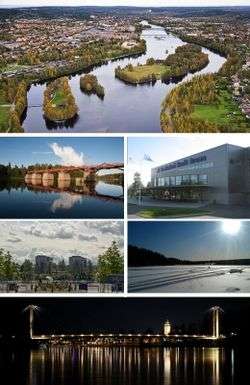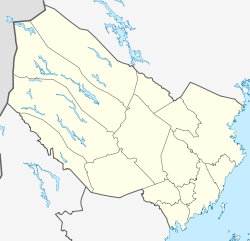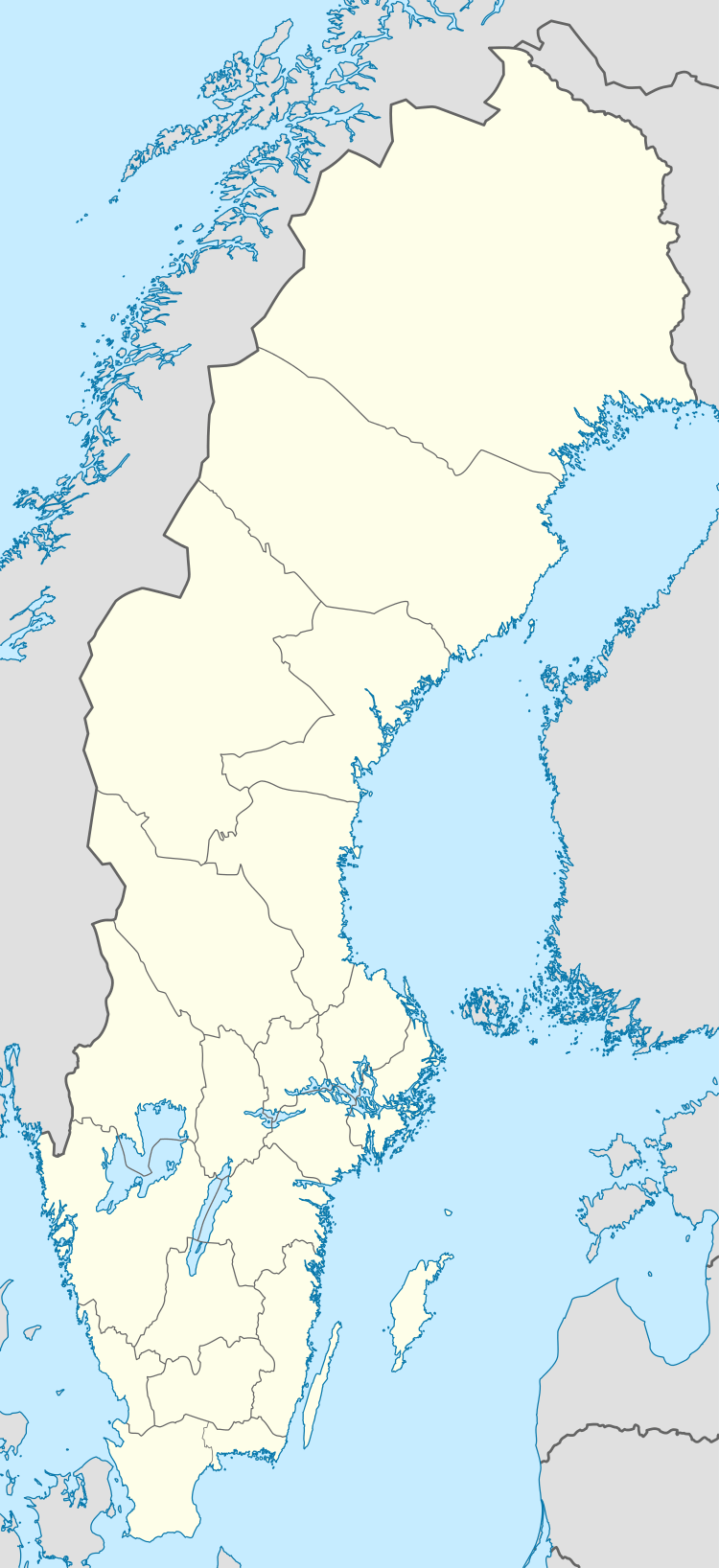Skellefteå
Skellefteå (Swedish: [ɧɛˈlɛ̌ftɛɔ], locally [ʂɛˈlɛ̌ftɛ] (![]()
Skellefteå | |
|---|---|
 Skellefteå in images | |
 Coat of arms | |
| Nickname(s): Schtaan, Guldstaden (Goldtown), Skellhell[1] | |
 Skellefteå  Skellefteå | |
| Coordinates: 64°45′N 20°57′E | |
| Country | Sweden |
| Province | Västerbotten |
| County | Västerbotten County |
| Municipality | Skellefteå Municipality |
| Area | |
| • City | 21.74 km2 (8.39 sq mi) |
| Population (31 December 2010)[2] | |
| • City | 32,775 |
| • Density | 1,507/km2 (3,900/sq mi) |
| • Urban | 72 025 |
| Time zone | UTC+1 (CET) |
| • Summer (DST) | UTC+2 (CEST) |
| Area code(s) | +46 0910 |
The city is a historically industrial city with mining being a large industry, especially for gold – hence the nickname "Gold Town". Politically it is a Social Democratic stronghold. The city is a well-known ice hockey town, with its main team Skellefteå AIK playing in the Swedish top division: the SHL, which they have won on several occasions.
The city was incorporated in 1845 and grew to its current population size mostly in the 1950s and 1960s, growing only slowly since. It is the second largest city in Västerbotten after Umeå and is located roughly halfway between it and Luleå. The Skellefte River passes through the city and it is located around 15 kilometres (9.3 mi) from the Bothnian Bay open sea. Skellefteå is served by Skellefteå Airport, abbreviated as SKF locally known as Falmark because of the village nearby, also around 15 kilometres (9.3 mi) from the city centre to the south.
History
The name Skellefteå is recorded to having been spelled as Skelepht in 1327. On Carta marina the name is spelt Skellitta. The origin of the name remains unknown, but is assumed to be of Sami origin.
From the 14th century on, attempts were made to Christianize Skellefteå. A parish was formed and a church built. However, – for the most part – the entire large Northern Swedish territory of Norrland was not Christianized until several hundred years after the rest of Sweden, and many northern areas such as Skellefteå remained unexplored well past the Middle Ages.
Not before the very end of the 17th century did the indigenous Sami people of Northern Sweden begin turning to Christianity, much due to the efforts by the Northern Swedish superintendent Mathias Steuchius, who worked hard to accomplish this. Several Sami priests were killed for this reason.
Eventually, the reason for the sudden awakened interest towards Skellefteälven and the surrounding areas were the great northern fishing grounds of salmon. The increased demand for fish was sparked by a stricter enforcement of the annual month-long fasting by the Catholic Church, whereby meat was substituted by fish.
The actual city of Skellefteå is one of the youngest cities of Norrland. It was founded in 1845 by the vicar Nils Nordlander.
Today
In the 20th century, Skellefteå evolved to an industrial and mining city and many wooden houses were demolished to make room for brick buildings. Skellefteå is now trying to become a leading city in education with the construction of Floraskolan, a school that mostly focuses on entrepreneurial learning.[3]
It will become the home of a massive battery plant made by Northvolt by circa 2023.[4]
The largest private employer in Skellefteå is the mining company Boliden AB, with about 1,200 employees. The mine's copper ore contains particles of gold, silver and platinum. Skellefteå is still referred to as the "Goldtown".
During the 1990s, the computer industry flourished, subsidiaries of Ericsson and Tieto Enator becoming important employers.
Industry
- Boliden AB, a big mining and smelting company
- Skellefteå Kraft, largest power company in Skellefteå
- Northvolt AB, lithium-ion battery cell manufacturing company[5]
Sports
- Skellefteå AIK, an ice hockey team in the highest Swedish league, Swedish Hockey League(SHL). 1978, 2013 and 2014 Swedish Champions.
- Morön BK, football club playing in Division 2 Norrland
- Skellefteå FF, football club playing in Division 2 Norrland
- Sunnanå SK, women's football (soccer)
- The Skellefteå Kraft Grandmaster Chess Cup 1999, one of the strongest all Swedish chess tournaments was won by IGM (International Grandmaster (chess)) Ulf Andersson. The event took place from March 26 – April 4, 1999. An international chess tournament, the final of the two-year World Cup series was held in Skellefteå from August 12 to September 3, 1989. The final sixteen grandmasters participating included three former World Chess Champions Garry Kasparov, Anatoly Karpov and Mikhail Tal.[6] The activities organized around the World Cup final included two performances in Skellefteå of Chess (musical), with music by Benny Andersson and Björn Ulvaeus of the pop group ABBA.[7][8]
Notable natives
People
Sportspeople
- Anders Andersson, ice hockey player
- Johan Alm, ice hockey player
- Viktor Arvidsson, ice hockey player for the Nashville Predators
- Johan Backlund, ice hockey player
- Evy Berggren, Gymnast, Olympic and World Champion
- Niclas Burström, ice hockey player
- Robert Dahlgren, racing driver
- Jimmie Ericsson, ice hockey player
- Jan Erixon, ice hockey player
- Tim Erixon, ice hockey player
- Toini Gustafsson-Rönnlund, skier
- Jonathan Hedström, ice hockey player
- Adam Larsson, ice hockey player
- Oscar Lindberg, ice hockey player for the Vegas Golden Knights
- Mats Lindgren, ice hockey player
- Joakim Lindström, ice hockey player
- Hanna Marklund, football player
- Hardy Nilsson, ice hockey player and later coach
- Joakim Nyström, tennis player
- David Rundblad, ice hockey player
- Patrik Wallón, ice hockey player
Other
- Per Olov Enquist, writer
- Joel Varg Johansson, streamer and member of the metal band Scythelord.
- Tore Frängsmyr, historian
- Ingrid García-Jonsson, Spanish-Swedish actress
- Peter Haber, actor
- Andreas "Vintersorg" Hedlund, musician
- Thomas Idergard, political commentator
- Stig Larsson, writer
- Stieg Larsson, writer
- David Lindgren, musician
- Anna Nordlander, painter
- Victoria Silvstedt, supermodel
- Henning Sjöström, lawyer
- Margot Wallström, former first Vice President of the European Commission and current Special Representative on Sexual Violence in Conflict with the UN. Foreign Secretary of Sweden 2014–2019.
- Helena Helmersson, CEO of H&M since 2020
Artists
- Moon Safari, a symphonic rock band.
- The Wannadies, an alternative rock band formed in 1988.
- Vintersorg, a metal band.
- Amber Oak, a pop-rock band.
Climate
Skellefteå has subarctic climate that is borderline continental with mild summers and cold and snowy winters. The climate is somewhat moderated by the Bothnia Bay, although marine effects are limited, ensuring very mild summer temperatures for a coastal area so far north. The surrounding municipality has an all-time high of 33.9 °C (93.0 °F)[9] during the 2014 Swedish heat wave, which is very hot given the latitude and proximity to a major body of water. Although summer highs traditionally averaged just below 20 °C (68 °F) it has been warmer in recent decades.
| Climate data for Skellefteå, Sweden | |||||||||||||
|---|---|---|---|---|---|---|---|---|---|---|---|---|---|
| Month | Jan | Feb | Mar | Apr | May | Jun | Jul | Aug | Sep | Oct | Nov | Dec | Year |
| Average high °C (°F) | −5 (23) |
−5 (23) |
0 (32) |
6 (43) |
13 (55) |
18 (64) |
21 (70) |
19 (66) |
13 (55) |
6 (43) |
0 (32) |
−2 (28) |
7 (45) |
| Average low °C (°F) | −13 (9) |
−13 (9) |
−8 (18) |
−2 (28) |
3 (37) |
8 (46) |
11 (52) |
10 (50) |
6 (43) |
1 (34) |
−5 (23) |
−9 (16) |
−1 (30) |
| Average precipitation mm (inches) | 42 (1.7) |
33 (1.3) |
32 (1.3) |
32 (1.3) |
35 (1.4) |
40 (1.6) |
57 (2.2) |
71 (2.8) |
65 (2.6) |
55 (2.2) |
61 (2.4) |
48 (1.9) |
571 (22.7) |
| Average precipitation days | 18 | 14 | 13 | 11 | 11 | 11 | 12 | 14 | 15 | 15 | 17 | 17 | 168 |
| Source 1: [10] | |||||||||||||
| Source 2: [11] | |||||||||||||
See also
- Westrobothnian
- Sollefteå (similar name)
- Morö backe
References
- https://web.archive.org/web/20050802111949/http://lokalhistoria.skelleftea.org/
- Some material has been translated and incorporated from sv:Skellefteå
- "Skellhell inte så illa som du tror". March 2011. Archived from the original on 20 June 2013. Retrieved 7 March 2014.
- "Tätorternas landareal, folkmängd och invånare per km2 2005 och 2010" (in Swedish). Statistics Sweden. 14 December 2011. Archived from the original on 10 January 2012. Retrieved 10 January 2012.
- Kommun, Skellefteå (2019-10-02). "Presentation av Floraskolan och Florahallen". www.skelleftea.se (in Swedish). Retrieved 2019-11-09.
- plats, Skellefteå se-Ge idéerna (2018-01-30). "Etablering av batterifabrik". portal.skelleftea.se (in Swedish). Retrieved 2019-11-09.
- Milne, Richard; Hall, Ben (2019-12-02). "Europe First: how Brussels is retooling industrial policy". www.ft.com. Retrieved 2020-03-09.
- Mark Crowther. "The Week In Chess 233". London Chess Center. Retrieved 2019-06-10.
- suentus po 147. "Skelleftea World Cup 1989". chessgames.com. Retrieved 2019-06-18.
- Invalidname. "Chess (musical)". en.wikipedia.org. Retrieved 2019-06-18.
- "Månadens väder Juli 2014" (in Swedish). SMHI. Archived from the original on 9 June 2015. Retrieved 3 November 2015.
- (in English) "Institute of Meteorology and Water Management". www.worldclimateguide.co.uk.
- "SMHI Climate Data 2002-2015 (based on temperature averages for Piteå and Bjuröklubb and SMHI temperature map 1961-1990)". SMHI. |date=April 2016
External links
![]()
| Wikivoyage has a travel guide for Skellefteå. |
- Skellefteå – Official site
- Tourist in Skellefteå – Tourist information in Swedish, English and German languages